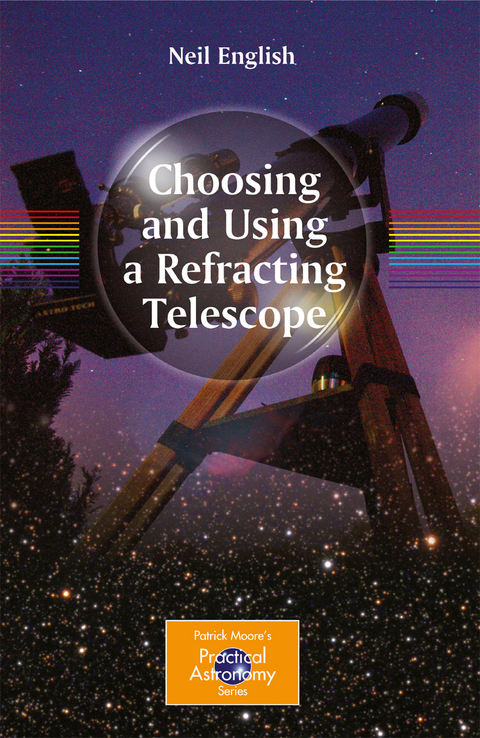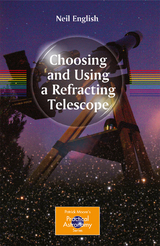Choosing and Using a Refracting Telescope
Springer-Verlag New York Inc.
978-1-4419-6402-1 (ISBN)
Choosing and Using a Refracting Telescope has been written for the many amateur astronomers who already own, or are intending to purchase, a refracting telescope – perhaps to complement their existing arsenal of larger reflecting telescopes – or for the specialist who requires a particular refractor for serious astronomical applications or nature studies.
Four hundred year ago, during the winter of 1609, a relatively unknown Italian scientist, Galileo Galilei designed a spyglass with two crude lenses and turned it skyward. Since then, refractors have retained their dominance over all types of reflector in studies of the Moon, planets and double stars because of the precision of their optics and lack of a central obstruction in the optical path, which causes diffraction effects in all commercially-made reflectors.
Most mature amateur astronomers got started with a 60mm refractor, or something similar. Thirty years ago, there was little choice available to the hobbyist, but in the last decade long focus crown-flint achromats have moved aside for some exquisitely crafted apochromatic designs offered by leading commercial manufacturers. There has been a huge increase in the popularity of these telescopes in the last few years, led by a significant increase in the number of companies (particularly, William Optics, Orion USA, StellarVue, SkyWatcher and AstroTech) who are now heavily marketing refractors in the amateur astronomical magazines.
In Choosing and Using a Refracting Telescope, well-known observer and astronomy writer Neil English celebrates the remarkable history and evolution of the refracting telescope and looks in detail at the instruments, their development and their use.
A major feature of this book is the way it compares not only different classes of refractor, but also telescopes of each class that are sold by various commercial manufacturers. The author is perhaps uniquely placed to do this, having used and testedliterally hundreds of different refracting telescopes over three decades.
Because it includes many diverse subjects such as imaging with consumer-level digital cameras, imaging with webcams, and imaging with astronomical CCD cameras – that are not covered together in equal depth in any other single volume – Choosing and Using a Refracting Telescope could become the ‘refractor bible’ for amateur astronomers at all levels, especially those who are interested in imaging astronomical objects of every class.
Dr. Neil English has a PhD in Biochemistry, and also a BSc in Physics & Astronomy. He is a Fellow of the Royal Astronomical Society, and a regular contributor to Astronomy Now (the UK’s major astronomy magazine), as well as to Ireland's Astronomy & Space. He is the author of Guide to Mars (Pole Star Publications, 2003). Neil’s astronomical images have been published in various magazines and journals, including a full page in the June 2006 issue of Astronomy. He has used and tested literally hundreds of refracting telescopes over a period of thirty years and has written about all aspects of this kind of instrument in the magazines. He owns and regularly uses a variety of refractors - both apochromat and achromat - which he uses from his home in rural Scotland.
Acknowledgments.- Introduction.- About the Author.- Part 1: The Achromatic Refractor.- Chapter 1: The Refracting Telescope - A Brief History.- Chapter 2: The Classical Achromatic.- Chapter 3: Rich-Field Achromats.- Chapter 4: Long Focus Achromats.- Chapter 5: Big Guns.- Chapter 6: Going Retro.- Part II: The Apochromatic Refractor.- Chapter 7: The APO Revolution.- Chapter 8: Doublet Apos.- Chapter 9: Sports Optics.- Chapter 10: Triplet Apos.- Chapter 11: Four Element Apos.- Chapter 12: Refractor Kit.- Chapter 13: Observing Platforms.- Chapter 14: Testing your Refractor.- Chapter 15: Photography with your Refractor.- Chapter 16: Looking Back, Looking Forward.- Appendix A: Refractor Design Through the Centuries.- Appendix B: Double Star Tests for Refractors of Various Apertures.- Appendix C: Useful Formulae.- Appendix D: Glossary.- Index
| Erscheint lt. Verlag | 29.9.2010 |
|---|---|
| Reihe/Serie | The Patrick Moore Practical Astronomy Series |
| Zusatzinfo | 20 Illustrations, color; 119 Illustrations, black and white; XII, 284 p. 139 illus., 20 illus. in color. |
| Verlagsort | New York, NY |
| Sprache | englisch |
| Maße | 155 x 235 mm |
| Themenwelt | Kunst / Musik / Theater ► Fotokunst |
| Sachbuch/Ratgeber ► Natur / Technik ► Weltraum / Astronomie | |
| Naturwissenschaften ► Physik / Astronomie ► Astronomie / Astrophysik | |
| ISBN-10 | 1-4419-6402-9 / 1441964029 |
| ISBN-13 | 978-1-4419-6402-1 / 9781441964021 |
| Zustand | Neuware |
| Haben Sie eine Frage zum Produkt? |
aus dem Bereich




